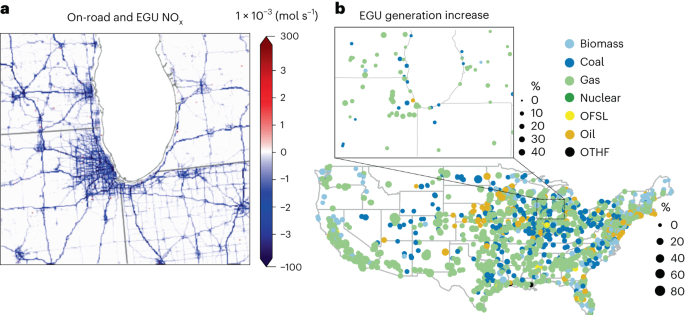2023-09-05 ノースウェスタン大学
◆この研究によれば、黒人、ヒスパニック、ラテン系住民の住む地域が最も恩恵を受け、歴史的にマージナライズされた地域における汚染と健康への負担を軽減する可能性があります。
<関連情報>
- https://news.northwestern.edu/stories/2023/09/electrifying-heavy-duty-vehicles-could-reduce-environmental-inequalities/
- https://www.nature.com/articles/s41893-023-01219-0
大型車の電動化が大気質、健康、公平性に及ぼす影響 Air quality, health and equity implications of electrifying heavy-duty vehicles
Sara F. Camilleri,Anastasia Montgomery,Maxime A. Visa,Jordan L. Schnell,Zachariah E. Adelman,Mark Janssen,Emily A. Grubert,Susan C. Anenberg & Daniel E. Horton
Nature Sustainability Published:05 September 2023
DOI:https://doi.org/10.1038/s41893-023-01219-0

Abstract
Heavy-duty vehicles (HDVs) disproportionately contribute to the creation of air pollutants and emission of greenhouse gases—with marginalized populations unequally burdened by the impacts of each. Shifting to non-emitting technologies, such as electric HDVs (eHDVs), is underway; however, the associated air quality and health implications have not been resolved at equity-relevant scales. Here we use a neighbourhood-scale (~1 km) air quality model to evaluate air pollution, public health and equity implications of a 30% transition of predominantly diesel HDVs to eHDVs over the region surrounding North America’s largest freight hub, Chicago, IL. We find decreases in nitrogen dioxide (NO2) and fine particulate matter (PM2.5) concentrations but ozone (O3) increases, particularly in urban settings. Over our simulation domain NO2 and PM2.5 reductions translate to ~590 (95% confidence interval (CI) 150–900) and ~70 (95% CI 20–110) avoided premature deaths per year, respectively, while O3 increases add ~50 (95% CI 30–110) deaths per year. The largest pollutant and health benefits simulated are within communities with higher proportions of Black and Hispanic/Latino residents, highlighting the potential for eHDVs to reduce disproportionate and unjust air pollution and associated air-pollution attributable health burdens within historically marginalized populations.



